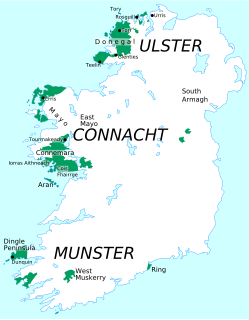
A bawn is the defensive wall surrounding an Irish tower house. It is the anglicised version of the Irish word bábhún, possibly meaning "cattle-stronghold" or "cattle-enclosure". The Irish word for "cow" is bó and its plural is ba. The Irish word for "stronghold, enclosure" is dún, whose genetive case is dhún'".
Máirtín Ó Cadhain was one of the most prominent Irish language writers of the twentieth century. Perhaps best known for his 1949 work Cré na Cille, Ó Cadhain played a key role in bringing literary modernism to contemporary Irish language literature. Politically, he was an Irish nationalist and socialist, promoting the Athghabháil na hÉireann, through Gaelic culture. He was a member of the post-Civil War Irish Republican Army with Brendan Behan during the Emergency.

Ulster Irish is the variety of Irish spoken in the province of Ulster. It "occupies a central position in the Gaelic world made up of Ireland, Scotland and the Isle of Man". Ulster Irish thus has more in common with Scottish Gaelic and Manx. Within Ulster there have historically been two main sub-dialects: West Ulster and East Ulster. The Western dialect is spoken in County Donegal and once was in parts of neighbouring counties, hence the name Donegal Irish. The Eastern dialect was spoken in most of the rest of Ulster and northern parts of counties Louth and Meath.

Connacht Irish is the dialect of the Irish language spoken in the province of Connacht. Gaeltacht regions in Connacht are found in Counties Mayo and Galway (notably in parts of Connemara and on the larger two Aran Islands. The Mayo and Galway varieties differ from each other in a variety of ways, as Mayo is geographically between Galway and Donegal, making Mayo Irish have a number of features in common with Donegal that Galway does not have.

Munster Irish is the dialect of the Irish language spoken in the province of Munster. Gaeltacht regions in Munster are found in the Gaeltachtaí of the Dingle Peninsula in west County Kerry, in the Iveragh Peninsula in south Kerry, in Cape Clear Island off the coast of west County Cork, in Muskerry West; Cúil Aodha, Ballingeary, Ballyvourney, Kilnamartyra, and Renaree of central County Cork; and in an Rinn and an Sean Phobal in Gaeltacht na nDéise in west County Waterford.
Cathal Ó Sándair (1922–1996), anglicised as Charles Saunders, was one of the most prolific Irish language authors.
Amhlaoibh Ó Súilleabháin was an Irish language author, linen draper, politician, and one-time hedge school master. He is also known as Humphrey O'Sullivan.
Seán Ó Tuama was an Irish poet, playwright and academic.
Marcas Ó Callanáin (1789–1846), Irish poet was born at Carheendiveane, Craughwell, County Galway, Ireland. He was the elder brother of Peatsaí, also a poet. Educated at the local school, he could speak Irish and English. His most well-known work is the love poem, Máire Brún.
Peatsaí Ó Callanáin (1791-1865) was an Irish poet.
Cín Lae Amhlaoibh is a diary written by Amhlaoibh Ó Súilleabháin (1780–1837) between the years 1827 to 1835. It is invaluable for the insight it gives into life in rural Ireland in the early 19th century, and is a rare example of an early modern diary written in the Irish language. Amhlaoibh's original manuscript is currently in the possession of the Royal Irish Academy.

Maighréad Ní Dhomhnaill is the début music album by Irish musician Maighread Ní Dhomhnaill. It was released in Ireland in 1976.
Tomás O Raghallaigh was an Irish short story writer.
Mícheál Ó hEidhin, Irish musician and teacher, and schools inspector of music, Primary/Postprimary born 1938. He died on 29 January 2012.
The Rev. Canon Cosslett Quinn, in Irish Cosslett Ó Cuinn was a priest of the Church of Ireland who translated the New Testament into Irish.
Máirtín Ó Murchú is an Irish professor of Celtic studies and emeritus professor of the Dublin Institute of Advanced Studies. He previously also was Director of the School of Celtic at DIAS and a Professor of Irish at Trinity College Dublin.
Deoraíocht is an Irish-language novel by Pádraic Ó Conaire. An English translation is published under the title Exile. Published in 1910, it is arguably the most important novel from the Gaelic revival. For many critics its radical social message, its sympathy with the poor and marginalised, its tendency to convey urban life honestly and fairly and its avoidance of romanticising rural life in comparison to urban life makes it the outstanding novel of the Gaelic revival.
Maidhc Dainín Ó Sé was an Irish-language writer and musician from the County Kerry Gaeltacht. He was the father of Dáithí Ó Sé. He was one of the best known Irish writers of his generation, noted for his autobiography A Thig Ná Tit Orm. His writings were used as part of the Irish-language element of the Leaving Certificate in Irish state education, as a replacement for Peig from 1995.
Glenmore is a location in County Kilkenny, Ireland.




